A new study combining genetic, palaeoecological, and archaeological evidence has shown the Persian Plateau as a critical geographic area that served as a hub for Homo sapiens during their early migration out of Africa.
This discovery gives new light on the convoluted path of human groups, refuting prior theories about our species’ migration into Eurasia.
The study, published in Nature Communications, focuses on a critical era between around 70,000 and 45,000 years ago when human groups did not spread uniformly over Eurasia, leaving a vacuum in our understanding of where they were during this time.
Our multidisciplinary study provides a more coherent view of the ancient past, offering insights into the critical period between the Out of Africa expansion and the differentiation of Eurasian populations. The Persian Plateau emerges as a key region, underlining the need for further archaeological explorations.
Professor Petraglia
Key findings from the research include:
- The Persian plateau as a hub for early human settlement: Using a novel genetic approach combined with palaeoecological modelling, the study revealed the Persian Plateau as the region where from population waves that settled all of Eurasia originated.
- This region emerged as a suitable habitat capable of supporting a larger population compared with other areas in West Asia.
- Genetic resemblance in ancient and modern populations: The genetic component found in Persian Plateau populations demonstrates the area’s long-term differentiation, which is consistent with the region’s hub nature, and is ancestral to the genetic components previously known to have inhabited the Plateau.
- A novel technique that separates 40,000 years of mixing and other complicating events enabled the discovery of such a genetic signature. This genetic link emphasizes the Plateau’s importance as a hub for early human colonization and later migrations.
Study co-author Professor Michael Petraglia, Director of Griffith University’s Australian Research Centre for Human Evolution, provided a much clearer picture of these early human movements.

“Our multidisciplinary study provides a more coherent view of the ancient past, offering insights into the critical period between the Out of Africa expansion and the differentiation of Eurasian populations,” Professor Petraglia said. “The Persian Plateau emerges as a key region, underlining the need for further archaeological explorations.”
First author Leonardo Vallini of the University of Padova, Italy, said: “The discovery elucidates a 20,000 year long portion of the history of Homo sapiens outside of Africa, a timeframe during which we interacted with Neanderthal populations, and sheds light on the relationships between various Eurasian populations, providing crucial clues for understanding the demographic history of our species across Europe, East Asia, and Oceania.”
Prof. Luca Pagani, the senior author, said: “The revelation of the Persian Plateau as a hub for early human migration opens new doors for archaeological exploration, enriching our understanding of our species’ journey across continents and highlighting this region’s pivotal role in shaping human history.”
















